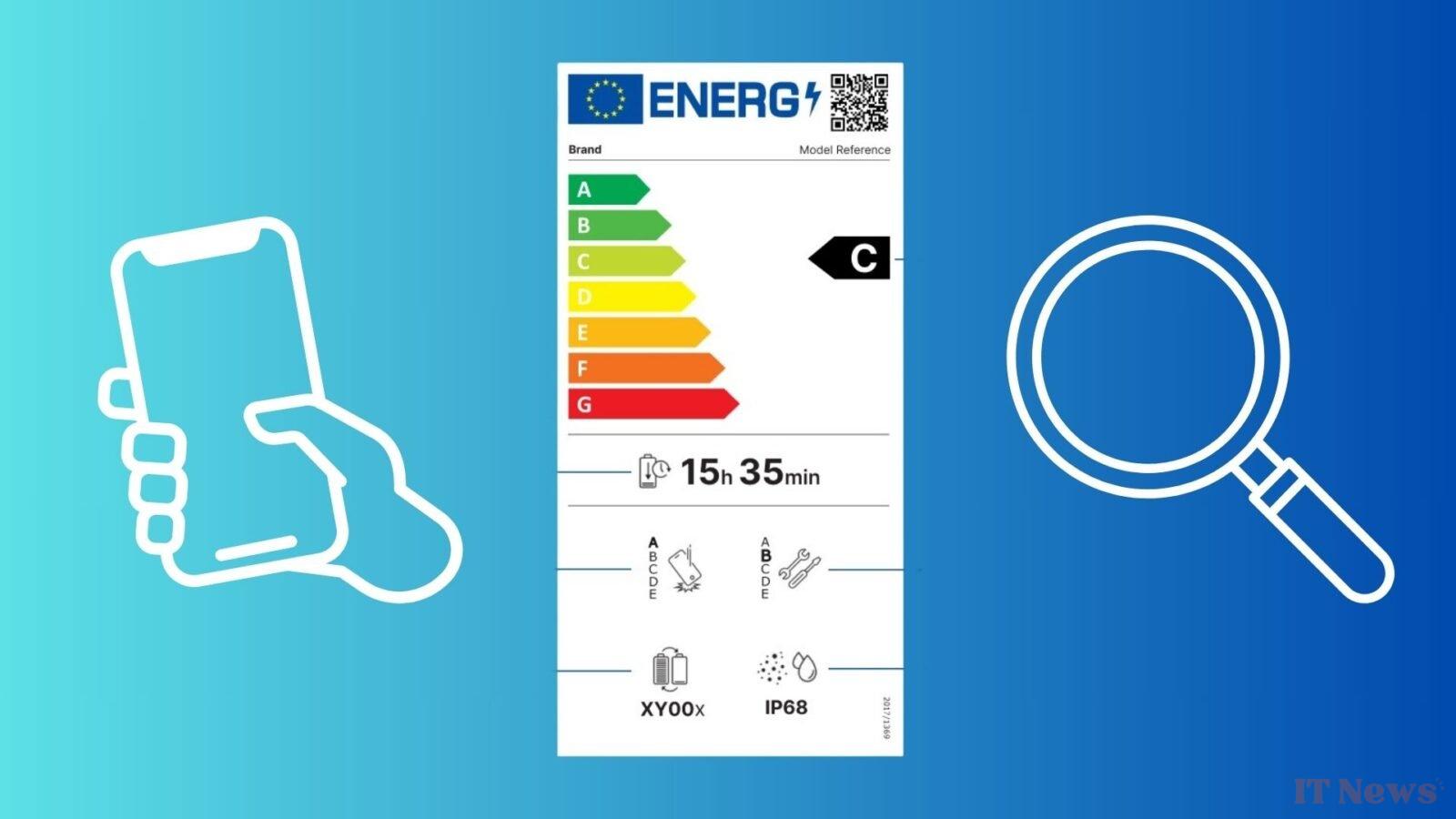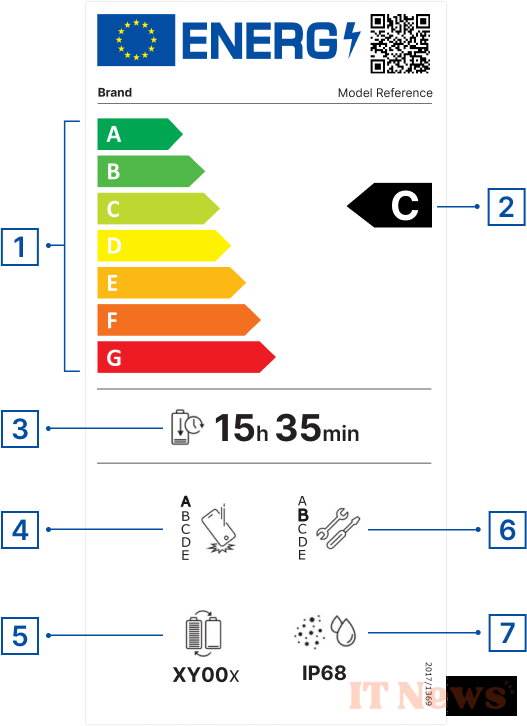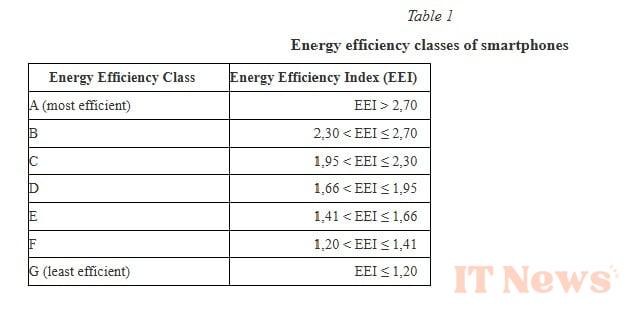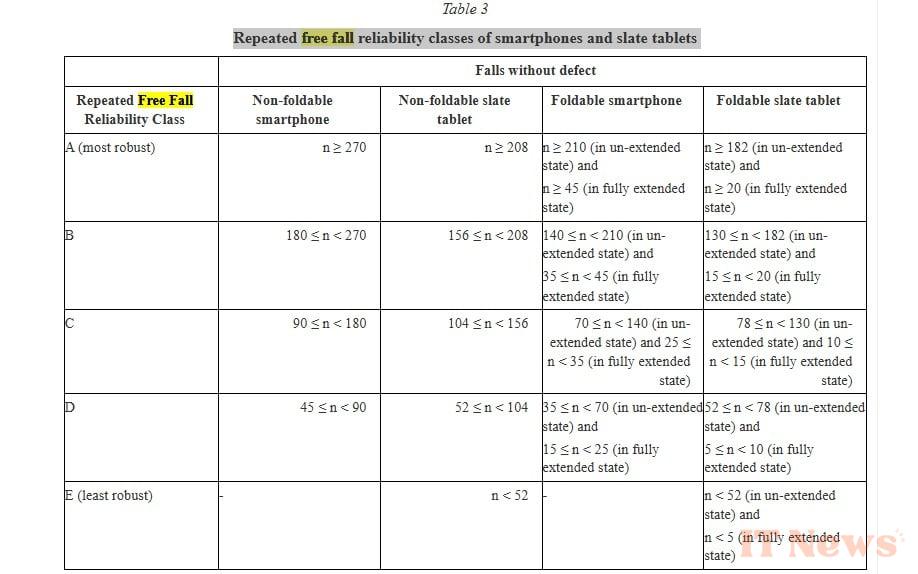Since June 20, 2025, Europe has imposed a set of new rules on manufacturers of electronic devices, and in particular on manufacturers of smartphones and tablets, which must now include an Energy label.
This will certainly remind you of the famous label that has been present on any household appliance for years. But if we look more closely, the elements that compose it are quite different.
To guide you throughout this article, we will use a label, for example, available on the site set up by the European Union. This is visible below and numbers the different interesting elements. We'll go over them.
Energy Efficiency Index (EEI) (items 1, 2, and 3)
The Energy Efficiency Index (EEI) ranges from A to G, with A being the best rating and G the worst. To calculate it, manufacturers must comply with strict specifications and the index can obviously be subject to control by the authorities, available directly in annex of the directive voted in 2023 and which led to all these changes.
Among the test requirements, we find for example the use of the browser pre-installed on the phone, the absence of a user account, a screen set to 200cd/m², the interface must be set to light mode, etc. The smartphone or tablet then performs a series of very specific actions that mimic the average user's usage: internet browsing, pause, video game, streaming, data transfer, etc.
The smartphone will repeat this sequence in a loop until it turns off. This then gives a duration in hours that can be seen on the label(item 3). This duration is then used in the following calculation, where END Device is the test duration.
"U nom" is the nominal voltage of the device and "C rated" is the battery capacity in mAh. This is then multiplied by 1000 and gives a value that allows the device to be located. This gives a decimal point number between approximately 1 and 3. All that remains is to place it in this table to obtain the famous letter of the index (element 1 and 2).
Important clarification: the EEI of a "smartphone or tablet must be calculated with the version of the operating system installed on the product model on the date it was placed on the market", the directive specifies. As long as the product is on the market, meaning for sale, manufacturers will have to update the EEI with each operating system update.
The drop index (item 4)
The label includes a drop index. This is classified from A to E. It is not measured in the same way for classic smartphones and foldable smartphones. Europe also distinguishes between tablets and foldable tablets, which we understand as book-sized smartphones like the upcoming Galaxy Z Fold 7.
Without going into the details of the table, remember that each score is obtained based on a number of 1m drops made by the device "without defect." It is important to note that a simple broken screen glass is not considered a defect. The EU here refers to a device that is still functional. If, after a fall, it loses the use of its WiFi connectivity or its microphone, for example, it will no longer be considered functional.
To obtain the best rating, here is the number of falls that different devices must obtain:
- More than 270 for a smartphone;
- More than 208 for a tablet;
- More than 210 for a closed foldable smartphone, more than 45 if it is open;
- More than 182 for a closed foldable tablet, more than 20 if it is open.
The number of battery cycles (item 5)
The number of battery cycles indicated on the label (item 5) indicates the number of charge and discharge cycles that can be carried out before the battery reaches 80% of its initial nominal capacity. The device will be "used" via a more or less robust automated script, called discharge rate by the document.
The manufacturer therefore performs 500 cycles with relatively modest use, a discharge rate of 0.2 C, measures the capacity and then moves on to a slightly more robust use, 0.5 C, in increments of 99 cycles, interspersed with a modest cycle at 0.2 C where a measurement of the battery capacity is carried out. It therefore seems impossible for a device to display a number of cycles that is not round. We will necessarily have something ending in a zero. A priori, no device should be measured below 500 cycles.
The repairability index (item 6)
As for the repairability index, item 6 on the label, we will not be able to go into as much detail as on the rest, as the calculation is so complex. Just remember that it combines six different scores:
- The “disassembly depth” score, measuring the complexity of disassembling a product based on the number of steps required without damaging the product.
- The fastening score, which measures the quantity of elements used to fasten the elements together in the device, but also their difficulty in being reused (screws, glue, etc.).
- The tools score, which measures the availability and complexity of the tools involved;
- The spare parts score, which again measures their availability;
- The software update score, which measures the update time. The best score is obtained from 7 years. Below 5 years, the product does not receive any points;
- The "repair information" score, which focuses on the availability of documentation on repairing the product.
Waterproof rating (item 7)
This is the easiest to explain, since it is already well integrated into the functioning of the Tech industry. The waterproof rating used by Europe is the Ingress Protection (IP) rating.
As a reminder, it is made up of two numbers. The number on the left, ranging from 0 to 6, provides information on protection against dust, solid objects, etc. The second number, ranging from 0 to 9, provides information on protection against water. Please note that from age 7, immersion is possible, and before that it is only a projection against water jets and projection.







0 Comments